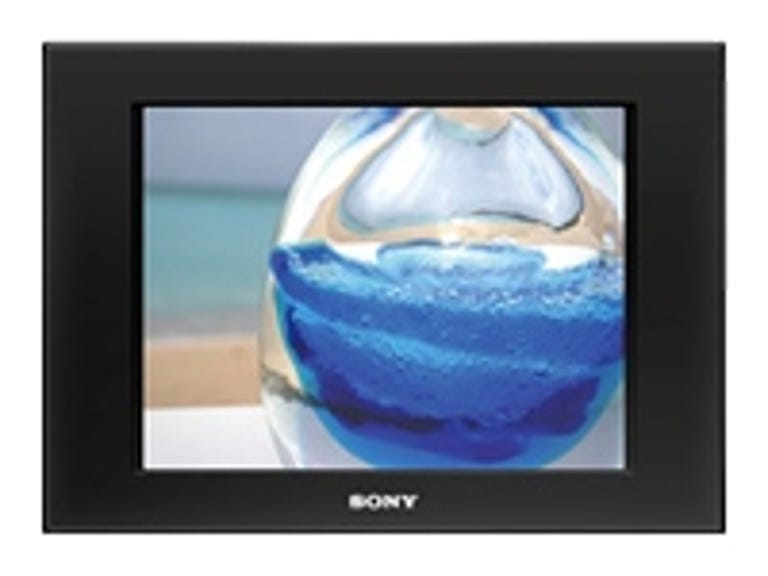 Why You Can Trust CNET
Why You Can Trust CNET Sony 8-inch Digital Photo Frame review: Sony 8-inch Digital Photo Frame
Sony 8-inch Digital Photo Frame
Easy to use and with a basic but solid feature set and above-average display quality, the Sony 8-inch Digital Photo Frame appeals to both the technophobic and undemanding technophiles who won't mind spending a bit extra for it.
The Good
The Bad
The Bottom Line
Made of glossy black plastic, which is only somewhat fingerprint resistant, the frame's understated yet high-tech appearance draws more attention to the photos than itself. Though the Sony logo on the bottom lights up by default, you can thankfully turn it off. Because it has a smaller bezel than most competitors, the D80's displayable area looks relatively large: the entire frame's dimensions are only 9 inches wide by 6.5 inches high by about 5.5 deep. It has a rotating kickstand that looks a bit like an old-fashioned radio antenna that allows you to easily position the frame vertically or horizontally. Given how small it is, it's quite stable. There are no holes to mount the frame on a wall, however.
On the right side are small power, menu, and navigation buttons, but the frame comes with a remote that's easier to use than those. Behind are slots for CompactFlash, SDHC/MMC/xD and Memory Stick Pro/Duo; on the opposite side there is a connector for the AC adapter as well as mini-USB. Unlike most frames, there's no full-size USB connector for a thumbdrive. In addition to copying files directly from a PC, there's a button on the remote to copy all or selected images on a card to the frame's internal memory; it can resize them during copy, if you choose. The D80 has 256MB built in, but only 200MB of that is available for images, and it seems like the frame maxes out at 500 photos regardless of size. In addition to JPEG, it can also display Sony ARW (raw) files, but the frame doesn't play video or audio.
You can choose from a few different views, either via the remote or by pressing a switch on the top of the frame: single, multi-image, clock, calendar, and random. In a nice touch, you can cycle through the single-image view to display EXIF information. The clock view is a bit confusing, since it displays the date and time when the accompanying photograph was taken rather than the current date and time. This might work a bit better for the calendar view, which instead shows current date and time. You can also just use the frame as a big LCD clock or calendar, white on black or black on white, analog or digital.
The menus are easy to navigate, primarily because the frame doesn't offer many options. These include a variety of display intervals, a few effects (but no None), and display order. The frame supports automatic rotation and display orientation; entire image versus fit-to-screen scaling; separate controls for the LCD backlight and brightness; an on/off timer; and support for the usual handful of Western languages as well as Russian, Japanese, and Chinese.
All things considered, the D80 operates pretty quickly. It's one of the faster models we've seen at copying and resizing images, and it can render large, full-size photos without hesitation. Only the index thumbnail display can get annoyingly slow, and it won't let you interrupt it until it's rendered all the thumbs on the screen.
I really like the display quality of this frame. With 800x600 resolution and a 4:3 aspect ratio, photos look sharp enough, with few jaggies. The D80 has a bit better dynamic range than I'm used to seeing; highlights and shadows render pretty well, colors and skin tones are pretty accurate, and there's little visible color contouring. As with all LCD frames, when the frame is positioned vertically the viewing angle on one side is only about 25 degrees before the image inverts/disappears.
Though it's a bit pricey for the basic features, the Sony 8-inch Digital Photo Frame DPF-D80 does provide everything most users probably want, especially the more technologically averse, as well as above average display quality.


